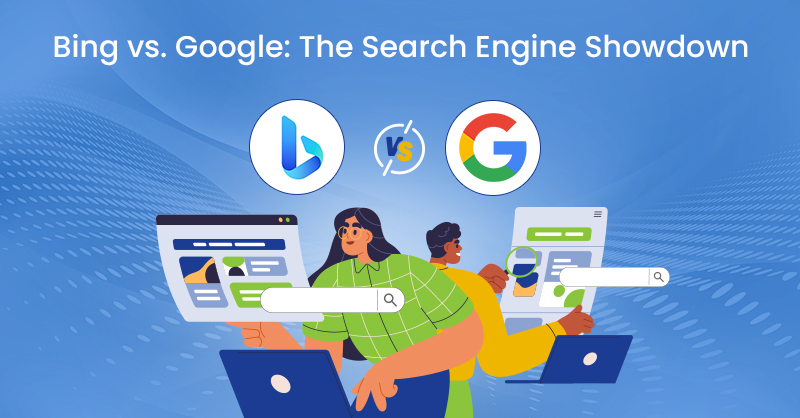A Brief History: Google and Bing
Google's transformation into a search engine powerhouse began in 1998, when Larry Page and Sergey Brin introduced “PageRank,” a revolutionary system that ranked web pages based on both the quantity and quality of links pointing to them. This innovation propelled Google to its dominant market position.
Understanding both Google and Bing is essential for digital marketers. Microsoft entered the search engine race after Google’s dominance, rebranding MSN Search to Live Search in 2006, and eventually launching Bing in 2009. Bing has since evolved, integrating advanced features and leveraging cutting-edge technology. To reach their audience effectively, marketers need a comprehensive understanding of both platforms.
Market Share: Google vs. Bing
Google's overwhelming dominance in the search engine market is evident, with an impressive 90.91%% global market share. Bing, with its Bing AI search, holds a more modest 3.64%, but Microsoft’s AI technology is making waves, suggesting a potential shift in the landscape.
While Google has a firm grasp, Bing has gained traction, particularly among specific user demographics and regional markets. The growth of Bing, particularly due to Microsoft Bing AI and Microsoft chatbots, highlights the importance of optimizing for both platforms.
User Experience and Interface Design
Both Google and Bing aim to provide intuitive, user-friendly interfaces, though they differ in key aspects, as shown below:
Search Results Page Layout
Google's results page is simple and clean, providing users with quick, relevant information. Bing, on the other hand, offers a visually enhanced experience with background images, prominent video and image options, and a sidebar for additional information. This design is particularly appealing for travel, entertainment, and image-heavy queries, especially when optimizing for multimedia content.
Advanced Search Options
Google's advanced search offers a range of search operators, enabling users to conduct sophisticated searches and refine results effectively. Bing’s search options, while simpler, are known for their ease of use. Bing integrates seamlessly with Microsoft products, while Google relies on Android-based devices for integration. Both platforms offer filters, tools, and customization options to suit diverse user needs.
The Algorithmic Battle: Ranking Factors and SEO
Google and Bing rely on complex algorithms to rank web pages, with many overlapping ranking factors. However, they differ in emphasis and implementation, which is important for digital marketers to consider.
On-Page SEO Considerations
On-page optimization techniques differ slightly between Google and Bing. Google prioritizes natural language use and comprehensive content that answers user queries thoroughly. It’s less reliant on exact-match keywords, focusing more on overall topic relevance. Bing, in contrast, places greater weight on traditional on-page SEO elements, such as relevant keywords in titles, headers, and content.
Here are some tips for optimizing content for both engines:
- Use relevant exact-match keywords naturally in your content, titles, and meta descriptions.
- Create comprehensive, in-depth content that covers topics thoroughly.
- Optimize header tags (H1, H2, H3) with relevant phrase-match keywords, especially for Bing.
- Ensure meta descriptions are compelling and include target keywords.
- Use alt text for images, incorporating relevant keywords where appropriate.
Technical SEO and Site Structure
While both engines value good technical SEO, there are some differences in their approaches.
Google places a higher emphasis on site speed, mobile-friendliness, and Core Web Vitals. It's also more particular about clean URL structures and the proper use of canonical tags. Bing, while forgiving of minor technical issues, still values a well-structured site. Additionally, XML sitemaps and clear internal linking are particularly important for Bing.
Site structure and crawlability are important for both platforms. Consider the following points below:
- Ensure a logical site structure with clear navigation.
- Use breadcrumbs to help search engines understand your site hierarchy.
- Implement proper internal linking to distribute page authority and aid content discovery.
- Ensure your robots.txt file doesn’t block important content.
- Maintain a flat site architecture, so that all pages are easily reachable from the homepage.
By understanding these algorithmic differences and implementing a balanced approach to SEO, digital marketers can optimize their websites to perform well on both Google and Bing, maximizing their visibility across the search landscape.
AI and Machine Learning in Search
Machine learning algorithms are revolutionizing search capabilities for both Google and Bing. Google's AI initiatives, including BERT and MUM, have enhanced its understanding of complex queries. Meanwhile, Bing AI search and Microsoft chatbots offer more interactive, conversational experiences.
Natural Language Processing Capabilities
Both search engines have made significant strides in natural language processing (NLP). Google excels at understanding context and user intent across languages, while Bing’s recent AI integration allows for more conversational interactions. Crafting content that is natural and aligned with user intent is essential to perform well on both platforms.
For many, these developments underscore the significance of crafting content that is not only natural, but also addresses user intent comprehensively. It's essential to tailor content to align with the unique understanding and processing of natural language queries by each search engine. This ensures a more effective approach to content creation and optimization for improved search engine performance.
Personalization and User Intent
Leveraging the power of AI, Google vs Bing have significantly improved their ability to understand user intent and deliver personalized search results. Google, drawing from its vast data ecosystem, provides highly customized outcomes tailored to individual user needs. Meanwhile, Bing taps into data from the Microsoft network, including platforms like LinkedIn.
To optimize for AI-driven search experiences, digital marketers should focus on comprehensive coverage of topics rather than keyword density. Craft content that not only addresses related queries, but also effectively fulfills user intent. Also, prioritize optimization for voice search and conversational queries to adapt to evolving search behaviours.
Advertising Platforms: Google Ads vs. Microsoft Advertising
Paid advertising remains a vital part of the digital marketing mix, with both platforms offering extensive options for market targeting.
Ad Performance and ROI
Google Ads offers broader reach and diverse targeting options, but often comes with a higher cost per click (CPC) due to increased competition. Microsoft Advertising, while reaching a smaller audience, generally features lower CPCs and can provide a higher ROI in specific industries or demographics.
To maximize ad performance on each platform, consider tailoring your strategies to leverage the strengths of Google Ads' extensive reach and targeting capabilities while also capitalizing on Microsoft Advertising's lower CPCs and potential for strong returns in specific market segments.
Audience Targeting and Remarketing
Both platforms provide sophisticated audience targeting options. Google’s vast network offers wide coverage on platforms like Facebook and Instagram. On the other hand, Microsoft Advertising stands out with its seamless integration into platforms like LinkedIn, making it a valuable tool for B2B marketers.
To maximize remarketing efforts on each platform, it’s crucial to understand the nuances of each audience and their behaviour, while tailoring strategies accordingly. By leveraging the strengths of Google’s broad network and Microsoft’s specialized B2B targeting through LinkedIn integration, advertisers can create comprehensive remarketing campaigns that effectively engage their target audiences across various touchpoints.
Multimedia Content and Visual Search
Google and Bing both offer impressive image recognition and visual search capabilities. Optimizing multimedia content for both engines is essential for reaching diverse audiences.
With its strong image recognition and visual search capabilities, Google Images sets the standard for visual search. It provides users with the ability to perform seamless visual searches, offering a wide reach and extensive opportunities for multimedia content optimization. This makes the platform an essential channel for digital marketers seeking to engage audiences through compelling visuals.
Bing’s image and video search capabilities are also impressive, offering a visually appealing layout that caters to specific content types. The platform allows users to search within images, find similar pictures, and even shop for products featured in images. Additionally, people can utilize descriptive file names and alt text for images, provide context through surrounding text, create engaging video content with optimized thumbnails and descriptions, and leverage schema markup for additional context.
Privacy, Data Usage, and User Trust
Both Google and Bing have faced privacy concerns regarding data collection. When it comes to concerns about privacy, Google has been more involved based on the broad data it has collected through various products. The company has taken steps to improve privacy settings, including features like incognito mode, clear privacy settings, and promises of user data protection.
After being rebranded under the Microsoft Corporation umbrella, Bing has marketed itself as a more privacy-conscious browser. Microsoft has worked to include tracking prevention in Edge and has collected less personal data than Google. This approach can be seen as advantageous for users who are concerned about their anonymity in a particular activity.
Balancing personalization with privacy concerns is key for digital marketers. Fortunately, there are strategies for addressing privacy concerns, such as:
- Being transparent about data collection and usage: Companies should clearly communicate to users what data they are collecting, how it will be used, and who it will be shared with. This helps to build trust and gives users the opportunity to make informed decisions about their privacy.
- Providing value in exchange for user data: Offering valuable products or services in exchange for user data is worth considering. This could include personalized recommendations, discounts, or access to exclusive content.
- Implementing strong data protection measures: Companies should invest in robust security measures to protect user data from unauthorized access or breaches. This includes encryption, secure storage practices, and regular security audits.
- Respecting user preferences for privacy and personalization: It’s crucial to allow users to easily set their privacy preferences and provide options for personalized experiences based on user consent. This could include opting out of targeted advertising or adjusting the level of personalization in their experience.
Conclusion
The Google vs Bing showdown highlights the unique strengths and features of each search engine, showcasing their importance in today’s digital world. While Google maintains its dominance with a vast user base, cutting-edge machine learning algorithms, and a robust advertising platform, Bing is quickly gaining ground with its AI-driven innovations, such as Microsoft Bing AI and Microsoft chatbots, making it a formidable competitor.
For digital marketers, understanding the nuances of both platforms—from user intent to technical SEO strategies— is critical for crafting effective campaigns. Optimizing for both search engines by incorporating high-quality dofollow backlinks, enhancing multimedia content, and leveraging social signals and SEO can significantly boost visibility and engagement. As Bing AI search continues to evolve and Google's generative AI capabilities expand, staying ahead of these developments will be key to maintaining a competitive edge.
Whether you’re targeting the broad reach of Google or capitalizing on Bing’s growing influence, a balanced, informed approach to SEO and advertising across both platforms will ensure your brand reaches its full potential in today’s search engine landscape.
Ready to dominate both Google and Bing? TechWyse Internet Marketing is your key to search engine success. Our seasoned SEO experts will craft a tailored strategy to maximize your visibility across both platforms.
Don't miss out on potential customers. Reach out to TechWyse today and unlock your full search engine potential!! Call 866-208-3095 or contact us here.





